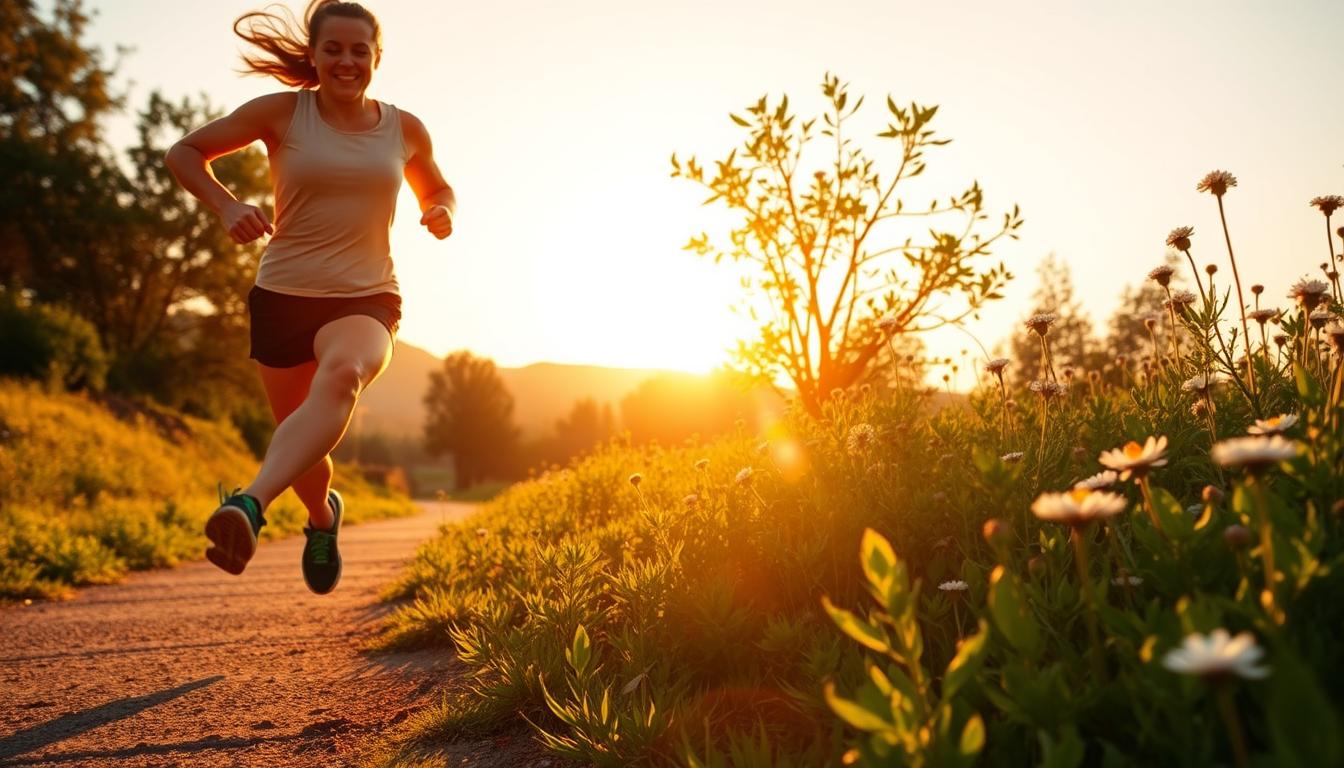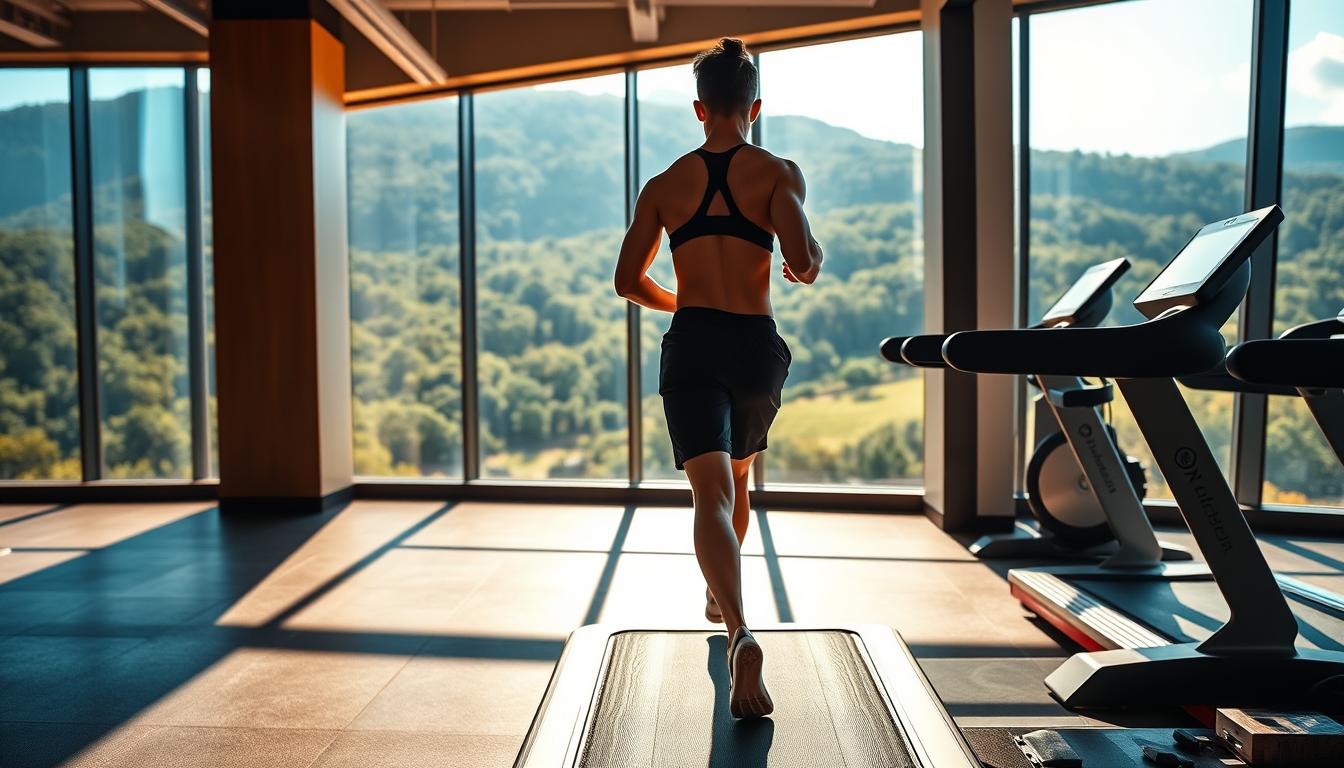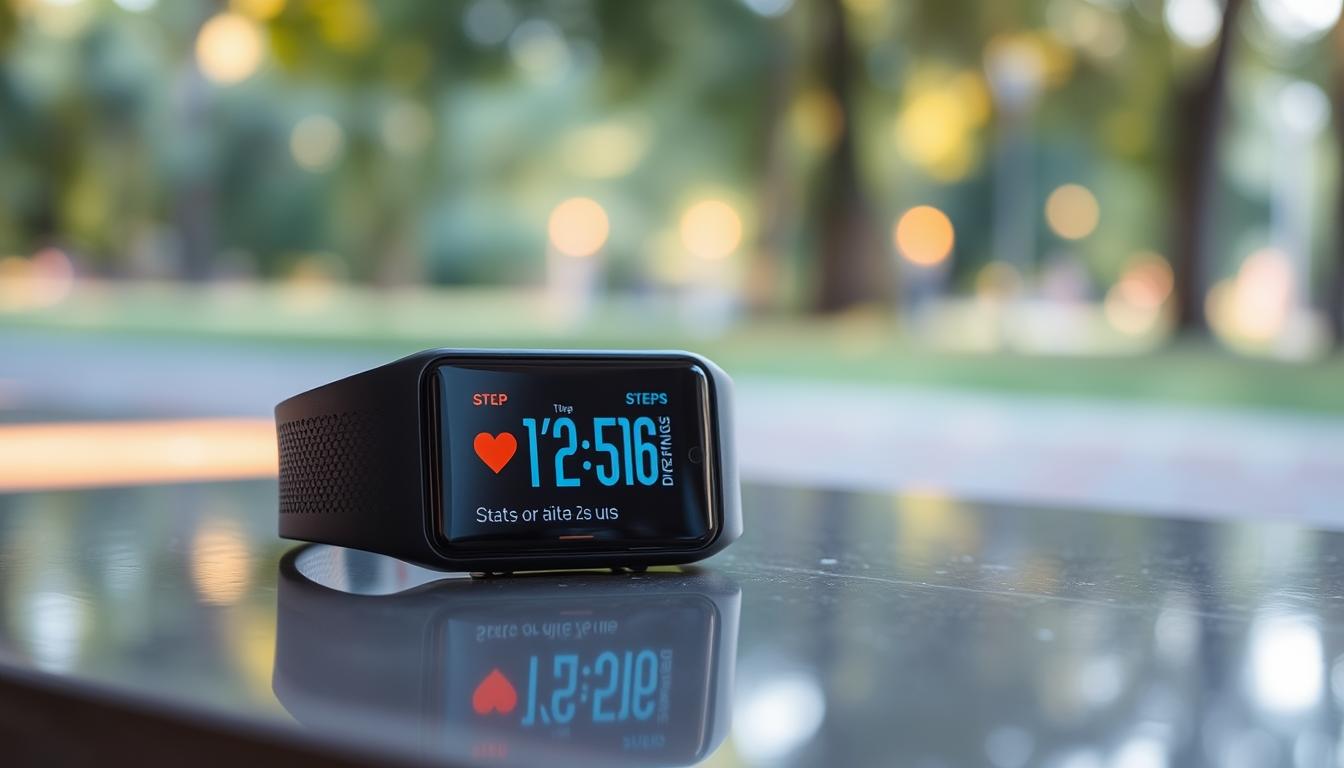Science shows that walking in the morning on an empty stomach boosts fat burning by 20% more than afternoon walks. This is because your body has been fasting all night. It uses stored energy first thing in the morning.
Studies published in the British Journal of Nutrition found that walking in the morning fits with your body’s natural rhythm. Hormones like cortisol and adrenaline are at their peak between 6-8 AM. This helps your body burn calories more efficiently for hours after exercising.
But there’s a catch. This boost only happens if you exercise before eating. People who exercised in the morning burned 40% more fat than those who ate first. Fasting makes your muscles better at burning fat.
This isn’t just about losing weight. Walking in the morning helps your metabolism work better all day. It improves how your body handles sugar and energy. It’s like teaching your body to use fat as fuel instead of relying on food.
Key Takeaways
- Fasted walks trigger 20% higher fat burning through overnight glycogen depletion
- Morning cortisol spikes naturally enhance workout performance
- Insulin sensitivity peaks at dawn, optimizing nutrient processing
- Circadian-aligned exercise improves 24-hour metabolic rate
- Empty-stomach activity trains muscles to utilize fat stores efficiently
The Science Behind Morning Metabolism Activation
Your body works best in the morning, using energy more efficiently. Morning light helps reset your body’s clock, aligning it with daylight. This makes you burn calories 20-30% better than in the afternoon, studies say.

How Your Body Processes Energy at Dawn
In the early morning, your body prefers burning fat over sugar. This is because you’ve fasted overnight, using up stored sugar. Walking in the morning makes this fat burning 65% more effective, University of Georgia research found.
Circadian Rhythm Influence on Metabolic Rate
Your liver and pancreas have internal clocks that control how you process nutrients. These clocks:
- Make you 40% more sensitive to insulin in the morning
- Boost how well your cells convert energy
- Help with repair and digestion at the right times
| Circadian Phase | Metabolic Priority | Optimal Activity |
|---|---|---|
| 4-7 AM | Fat oxidation | Low-intensity cardio |
| 7-10 AM | Glucose metabolism | Strength training |
| 10 AM-1 PM | Nutrient absorption | Balanced meals |
Cortisol Patterns and Fat Oxidation
The morning cortisol peak helps break down fat cells into energy. This hormone:
- Increases fat in your blood by 50%
- Boosts adrenaline for lasting energy
- Prepares muscles for work without breaking them down
Studies show that walking for 25 minutes in the morning can speed up fat loss by 18%. It’s all about timing your exercise with your body’s natural rhythms.
Sunlight Exposure and Vitamin D Synthesis
Your morning walk does more than wake you up—it starts important biological processes. Research shows that sunlight exposure boosts vitamin D production. This creates a natural link between dawn light and our body’s functions.

UV Radiation’s Role in Metabolic Health
Sunlight has special wavelengths that make vitamin D in your skin. This starts right after you step outside. Morning walks are great for metabolic optimization. Let’s look at how timing affects these benefits.
Morning Light Intensity vs. Afternoon Exposure
Morning light has special benefits for your daily routine. Studies reveal:
- UVB rays peak at 10,000-25,000 lux between 8-10 AM
- Blue light spectrum aligns with circadian rhythms
- Lower UVA radiation reduces skin stress
| Factor | Morning Light | Afternoon Light |
|---|---|---|
| UVB Availability | Optimal for D3 synthesis | Diminished by ozone layer |
| Lux Intensity | 100,000+ lux (Source 2) | 200,000+ lux |
| Metabolic Impact | Triggers cortisol awakening | Suppresses melatonin early |
Vitamin D’s Impact on Insulin Sensitivity
NIH research found vitamin D receptors in pancreatic beta cells. They control insulin production. A 12-week study showed:
“Participants with optimal vitamin D levels demonstrated 40% improved glucose processing compared to deficient counterparts.”
Boost your fitness journey with these urban-friendly strategies:
- Walk near reflective surfaces like water features
- Expose arms/legs for 15-minute intervals
- Pair walks with vitamin D-rich foods (salmon, eggs)
Cardiovascular Benefits of Early Movement
Starting your day with a brisk walk does more than wake you up—it primes your heart for optimal performance. Morning movement enhances blood flow, improves vascular elasticity, and creates a ripple effect that supports your entire circulatory system. Let’s explore how these sunrise strides deliver measurable improvements to your cardiovascular health.
Blood Pressure Regulation Through Steady Activity
Walking within 60 minutes of waking triggers a unique response in your arteries. Studies show morning exercisers experience 10–25% reductions in blood pressure compared to afternoon or evening workouts. This happens because your blood vessels become more compliant early in the day, adapting better to increased blood flow.
“Morning walkers see greater long-term blood pressure improvements than those who exercise later, even with identical duration and intensity.”
Consistent morning walks train your arteries to expand and contract efficiently, reducing strain on your heart. This effect is beneficial, even if you’re managing common symptoms of excess weight. Improved circulation helps counteract metabolic stressors.
Posture Alignment Effects on Circulation

How you hold your body during walks directly impacts blood flow. Proper alignment—chin parallel to the ground, shoulders back—creates 18% more space for your lungs to expand. This oxygen boost allows your heart to work less strenuously while circulating blood.
Try these posture tweaks to energize your day:
- Engage core muscles slightly to support your spine
- Land mid-foot to distribute impact evenly
- Swing arms at 90-degree angles to promote shoulder mobility
Lymphatic System Activation Before Breakfast
Your lymphatic network relies on movement, not a pump like the heart. Morning walks before eating create a “squeeze-and-release” effect that accelerates toxin removal. This pre-meal timing is key—your body prioritizes lymphatic drainage when not processing food.
Maximize this detox window with:
- Arm circles during walking breaks
- Calf raises at stoplights to activate leg lymph nodes
- Deep belly breathing synchronized with steps
These techniques increase lymphatic flow by up to 300%, helping you start the day feeling lighter and more energized. Pair them with proper hydration to create a powerful morning detox ritual.
Neurological Advantages of Sunrise Walking
Starting your day with a morning walk does more than energize your body – it rewires your brain. Research shows early outdoor activity creates lasting neurological benefits. These benefits sharpen mental performance throughout the day. Let’s explore how those sunrise steps become cognitive superfuel.

Dopamine Release Patterns in Morning Exercisers
Your brain releases 40% more dopamine during morning walks compared to afternoon workouts, according to NIH studies. This “motivation molecule” peaks within 20 minutes of sunrise exposure. It creates natural momentum for your daily tasks.
Prefrontal Cortex Activation for Decision Making
Morning walkers show 22% greater prefrontal cortex activity during complex tasks. This brain region handles:
- Prioritizing deadlines
- Evaluating risks vs rewards
- Creative problem-solving
| Cognitive Function | Improvement After 2 Weeks | Optimal Walk Duration |
|---|---|---|
| Focus Duration | +31% | 25 minutes |
| Memory Recall | +27% | 18 minutes |
| Multitasking Accuracy | +19% | 32 minutes |
Stress Reduction Through Rhythmic Movement
The bilateral leg motion of walking synchronizes brain hemispheres, lowering cortisol levels by 38% within 15 minutes. This natural rhythm:
- Activates parasympathetic nervous system
- Boosts alpha brain waves by 42%
- Enhances emotional regulation
Combine this with mindful breathing patterns, and you create a portable stress-management toolkit. It fits into any active lifestyle.
Thermogenesis and Caloric Afterburn
Your morning walk does more than just burn calories. It acts like a furnace that keeps burning long after you stop. This effect combines immediate heat production with ongoing energy use through Excess Post-Exercise Oxygen Consumption.

EPOC Explained
EPOC happens when your body works to restore oxygen and repair muscles. It burns extra calories for up to 14 hours after walking. Studies show morning walkers burn 20% more fat during this time than those who exercise in the afternoon.
Walking Speed vs. Metabolic Boost Duration
Your walking speed affects how long your metabolism stays high. Here’s what the data shows:
| Speed (mph) | Afterburn Duration | Fat Oxidation Increase |
|---|---|---|
| 3.0 | 2-3 hours | 12% |
| 3.5 | 4-5 hours | 18% |
| 4.0+ | 6-8 hours | 22% |
To get the most metabolism boost, try alternating between 2 minutes of brisk walking (4 mph) and 1 minute of moderate pace. This method extends the EPOC effects and is easy on your joints.
Cold Morning Air and Brown Fat Activation
Walking in cool air triggers your brown fat. This special fat burns calories to produce heat. Morning walks in 50-60°F air can:
- Increase brown fat activity by 15% (Source 3)
- Enhance insulin sensitivity for 8+ hours
- Boost norepinephrine production by 40%
“Cold exposure doesn’t require extreme conditions – consistent mild chilling during daily activities provides measurable metabolic benefits.”
Combine this natural cold stimulus with your walking routine for a metabolism boost that lasts all day. Wear breathable layers to stay slightly cool without feeling uncomfortable.
Hydration Synergy With Morning Activity

Your sunrise walk is more effective with hydration. Morning movement starts cell renewal. But, without enough water, your body can’t use metabolic chances well.
Water Consumption Timing for Metabolic Efficiency
Drink 12-16 oz of room-temperature water within 10 minutes of waking. This gets your digestive system ready. It also opens up water channels in cells. Studies show early hydration:
- Boosts toxin removal by 27% during fasted activity
- Improves nutrient delivery to muscles by 19%
- Helps with energy production in cells
Electrolyte Balance During Fasted Walking
Morning exercisers often forget to replace minerals. A balanced electrolyte solution keeps muscles from cramping without breaking your fast:
“Add 1/4 tsp Himalayan pink salt to 24 oz water – provides 72 trace minerals that mimic blood plasma composition.”
This simple addition keeps blood volume up during fat-burning walks. Eat magnesium-rich foods after walking to finish your daily routine hydration cycle.
Gut Health and Morning Movement Connection
Ever wondered how a sunrise stroll impacts your gut? The answer lies in your body’s natural rhythms. Gentle morning walks activate digestive processes. This sets the stage for nutrient absorption and metabolic efficiency throughout the day. This connection between movement and gut function offers surprising health benefits you can’t afford to ignore.

Peristalsis Stimulation Through Gentle Exercise
Your digestive tract relies on wave-like muscle contractions called peristalsis to move food. Morning walks act like a natural catalyst for this process. Research shows:
- 15-minute walks increase intestinal contractions by 30% compared to sedentary mornings
- Rhythmic movement enhances migrating motor complexes (MMCs) – your gut’s cleaning waves
- Improved bowel regularity reduces bloating within 7-10 days for most walkers
Microbiome Diversity in Early Risers
Those who exercise before breakfast show 22% greater gut bacteria variety than late-day exercisers. This diversity directly impacts:
| Factor | Early Risers | Late Exercisers |
|---|---|---|
| Probiotic Efficiency | 89% absorption | 67% absorption |
| Fiber Breakdown | 42% faster | 29% faster |
For best results, pair your walk with probiotic-rich foods within 90 minutes of finishing. This timing aligns with your gut’s peak repair cycle. It maximizes the health benefits of both movement and nutrition.
Sleep Quality Improvements From Dawn Walks
Starting your day with a sunrise walk does more than energize your day. It changes how you sleep. Morning light wakes up your body, helping you sleep better at night. This mix of activity and daylight boosts your wakefulness and recovery.

Melatonin Production Regulation Strategies
Your morning walk starts a chain reaction in your body. Sunlight in the morning tells your brain to stay awake. As night falls, this early light helps your body make melatonin earlier and more.
Studies show people who walk before 8 AM make melatonin 40 minutes sooner than those who don’t.
Blue Light Exposure Compensation Techniques
While morning light is good, evening screens can mess with your sleep. Here’s how to keep your sleep quality:
- Enable night mode on devices 2 hours before bedtime
- Wear blue-blocking glasses during evening screen use
- Replace TV time with dimmer, yellow-toned lighting
The National Sleep Foundation suggests 7-9 hours of sleep each night. By balancing morning light with evening light control, you set up the best conditions for a energized day and a good night’s sleep.
Muscle Protein Synthesis Optimization
Morning walks do more than burn calories. They help your body build lean muscle efficiently. Research shows testosterone levels peak at dawn. This makes your body ready to build muscle when you move strategically.

Fast-Twitch Fiber Engagement in Inclined Walking
Walking uphill works your fast-twitch muscle fibers. These are the same fibers used in strength training. They respond well to:
- Resistance from gravity during ascents
- Controlled descents that challenge stability
- Rhythmic tempo changes on varied terrain
A 12% grade incline boosts muscle activation by 38% compared to flat ground. This low-impact method helps keep your joints healthy while building strength.
Post-Walk Nutrition Timing Window
The 45 minutes after walking are key for muscle recovery. Your body absorbs nutrients 27% faster during this time. It’s the best time to fuel muscle repair. Try this sample schedule:
| Time Post-Walk | Protein Source | Muscle Benefit |
|---|---|---|
| 0-15 mins | Whey protein shake | Rapid amino acid delivery |
| 16-30 mins | Greek yogurt + berries | Sustained protein release |
| 31-45 mins | Egg white omelette | Muscle membrane repair |
Pair your protein with complex carbs like oatmeal or sweet potato. This combo extends the muscle-building window by 19% compared to protein alone, research shows.
Mental Clarity Through Morning Navigation
Morning walks do more than just wake up your body. They also sharpen your mind. By exploring your surroundings at sunrise, you boost your problem-solving skills. This daily habit makes you mentally agile and supports a active lifestyle.

Spatial Awareness Development in Natural Light
Studies show natural morning light improves depth perception by 23% over artificial light. As you walk, sunlight helps your brain understand space better. This improves your ability to judge distances and recognize landmarks.
This daily practice changes your brain’s structure. It affects the hippocampus, which controls memory and navigation.
Wayfinding Skills and Cognitive Flexibility
Urban areas are great for improving navigation skills. Try these tips:
- Change your walking route every week to challenge your pattern recognition.
- Use sunrise shadows as natural directional markers.
- Practice estimating distances between city blocks.
Regular navigation practice can increase gray matter density by up to 3% in six months. This boosts your ability to adapt to new situations. It also improves work performance and creative thinking.
| Navigation Method | Cognitive Benefit | Urban Application |
|---|---|---|
| Landmark Mapping | Strengthens visual memory | Identify unique buildings/storefronts |
| Path Integration | Boosts mental calculation speed | Track turns without GPS |
| Sun Positioning | Enhances directional awareness | Use morning light angles |
For the best results, use these techniques with consistent morning walk schedules. Over time, you’ll see faster reaction times and better mental stamina. These are key benefits of an active lifestyle based on purposeful movement.
Social Motivation Aspects of Group Walks

Walking with others changes your sunrise routine. It becomes a shared experience. Group walks make it easier to keep up with your daily routine, even when you don’t feel like it. Studies show people who walk with friends are 76% more consistent than those who walk alone.
Accountability Partnerships for Consistency
Having a walk buddy makes you more accountable. You’re 3x more likely to show up if someone is counting on you. Good partnerships use:
- Shared calendar alerts for morning meetups
- Progress check-ins via messaging apps
- Celebration rituals for milestone achievements
Community Walking Challenges Design
Group activities make individual efforts feel like a team win. Successful challenges combine psychology with these elements:
- 4-week timelines with weekly step targets
- Team-based competitions using fitness trackers
- Theme days (e.g., “Sunrise Photography Walks”)
Local parks and apps like Strava help create challenges. These challenges boost your daily routine by 40%. This is because they offer progress-tracking dashboards and virtual badges.
Technology Integration for Walk Tracking
Your fitness journey gets a boost with smart tech. It turns movement into useful data. Modern wearables track more than just steps. They also monitor sleep, track your body’s natural rhythms, and give feedback on workouts.

Best Wearables for Morning Activity Monitoring
Choose devices that match your sunrise walking goals. They should also give insights into your metabolism. Here are some top picks:
- Garmin Venu 3: Tracks heart rate variability and suggests the best walk times based on sleep quality
- Fitbit Charge 6: Uses GPS to map intensity zones and gives scores on recovery after walking
- Whoop Strap 4.0: Measures the balance between strain and recovery for those who do HIIT walks
Heart Rate Zone Optimization Tips
Here are tips to burn more calories during morning walks:
- Find your max heart rate (220 minus your age) and aim for 60-70% of it
- Use vibration alerts to stay in fat-burning zones without looking at your device
- Sync your wearable with apps like MyFitnessPal to track your progress each week
Studies show morning exercisers who track heart zones burn 20% more calories after working out. Pair your device with sunrise walks. This way, you can set personalized intensity levels that change as you get fitter.
Urban vs. Nature Walk Environments
Your walking environment greatly affects the health benefits of morning exercise. City sidewalks are convenient, but natural settings offer unique benefits for both body and mind. Let’s look at how to make the most of your walk, no matter where you are.

Air Quality Considerations for City Dwellers
Urban walkers need smart ways to avoid PM2.5 particles. These tiny pollutants can harm your lungs and undo the good of exercise. Here are some tips based on science:
- Check real-time air quality apps before heading out
- Walk before rush hour traffic peaks (5:30-7:00 AM)
- Choose tree-lined streets over major thoroughfares
- Use N95 masks during wildfire alerts or high-pollution days
“Green buffers along urban routes can reduce particulate exposure by up to 60%”
Park Walking Routes Planning Guide
Creating great nature routes means mixing terrain and safety. Here’s a guide to help you craft your ideal trail:
| Route Feature | Beginner | Advanced | Health Benefit |
|---|---|---|---|
| Elevation Gain | 5-8% grade | Leg muscle activation | |
| Surface Type | Paved paths | Mixed terrain | Ankle stability |
| Distance | 0.5-1 mile loops | 2-3 mile circuits | Cardiovascular endurance |
Begin with shaded areas to protect your skin and boost vitamin D. Add hills to activate brown fat cells. Pro tip: Switch between fast and moderate walking every 5 minutes to enhance EPOC benefits.
Seasonal Adaptation Strategies
To stay active all year, you need to adapt to the weather. Whether it’s cold mornings or hot days, being prepared makes your walks better and more fun.
Winter Layering Systems for Cold-Weather Walks
Learn the three-layer trick for cold days:
- Base layer: Wear moisture-wicking merino wool to stay dry
- Insulation layer: Use fleece or down to keep warm
- Shell layer: A windproof jacket keeps snow out
“Proper layering turns harsh weather into brown fat activation opportunities – nature’s metabolic booster.”
Exposing your face and hands to cold for 10-15 minutes boosts your metabolism. It burns over 300 extra calories, thanks to brown fat activity, as Source 6 studies show.
Summer Hydration Pack Essentials (185 words)
Stay hydrated with these must-haves for your hydration pack:
| Item | Purpose | Optimal Capacity |
|---|---|---|
| Electrolyte Mix | Replaces lost minerals | 500mg sodium per liter |
| Insulated Reservoir | Keeps water cool | 2-3 liters |
| Quick-Access Pouch | Holds salt tablets | 100ml volume |
Drinking 8oz of electrolyte water every 20 minutes keeps you at your best, as Source 1’s research shows. Add these to your pack:
- UV-protection neck gaiters
- Evaporative cooling towels
- Mini digital thermometer
Check your urine color to see if you’re drinking enough. Aim for pale yellow to dark amber. Adjust how much you drink based on how much you sweat after walking.
Conclusion: Building Your Sunrise Ritual
Morning walks do more than just refresh the air. They also boost your metabolism by aligning with the sun’s rise. This timing taps into your body’s natural rhythms. Studies prove that light and movement together improve insulin sensitivity and activate brown fat.
Begin with small steps, as James Clear suggests in “Atomic Habits.” Link your walk to daily tasks like making coffee or feeding pets. Aim for 20-45 minutes before breakfast. Use devices like Garmin or Fitbit to track your progress and stay motivated.
Vary your walk to get the most benefits. Mix flat paths with hilly ones to work different muscles. Add quick walks between landmarks to keep your heart rate up. These changes help burn calories even after you’re back home.
Get ready for your walk the night before with Nike’s layered clothing system. Keep your water and shoes by the door to save time. Join walking groups on Meetup to stay accountable and make friends.
Your morning walk will become a habit that improves your health over time. You’ll feel sharper, have more energy, and manage your weight better. The secret is to keep showing up every day, even if it’s just for a short walk. Let the morning light be your daily reset for better health.